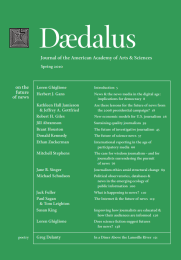What is happening to news?
In 1929, when he published A Preface to Morals, Walter Lippmann was well on his way to becoming the most influential journalist of his era. He had been editor of the editorial page of the New York World since 1922. Two of his books –Liberty and the News and Public Opinion–had outlined most of the key elements of the twentieth century’s concept of journalistic professionalism. Public Opinion had also suggested some of the concept’s limitations, foreshadowing the philosophical skepticism that much later in the century helped to undermine it. In fact, by 1929 deep doubt darkened Lippmann’s thought; he was losing his belief in the capacity of the democratic public to guide policy. He yearned for a better way but could not quite find it. A Preface to Morals recorded his intellectual struggle with how to live in a world without the hope of certainty. Though he believed in the power of science to repair some of the weaknesses of democracy, it was in resignation that he wrote:
Scientific method and historical scholarship have enormously increased our competence in the whole field of physics and history. But for an understanding of human nature we are still largely dependent . . . upon introspection, general observation, and intuition. There has been no revolutionary advance here since the Hellenic philosophers.1
Today, professional journalism is in a crisis Lippmann could not have imagined. The late-twentieth-century revolution in information technology and data transmission has threatened the viability of the businesses–primarily newspapers–that gathered, sorted, verified, and prioritized information about the important events of the day. While it perfected people’s ability to communicate whatever they pleased, the revolution made it very difficult for anyone to get attention. It brought liberty and plenty to the system of free expression, and yet at the same time it subverted journalistic discipline and the fragile sense of order offered by the mosaic of the newspaper page.
Meanwhile, the news audience has changed its habits in fundamental ways. This transformation is not just a matter of switching from print to the Internet. The audience has been shrinking for decades, but today, even among the heaviest news consumers–such as those who watch cable news–an increasing proportion is drawn to the latest and most . . .
Endnotes
- 1Walter Lippmann, A Preface to Morals (New York: MacMillan, 1929), 157.
